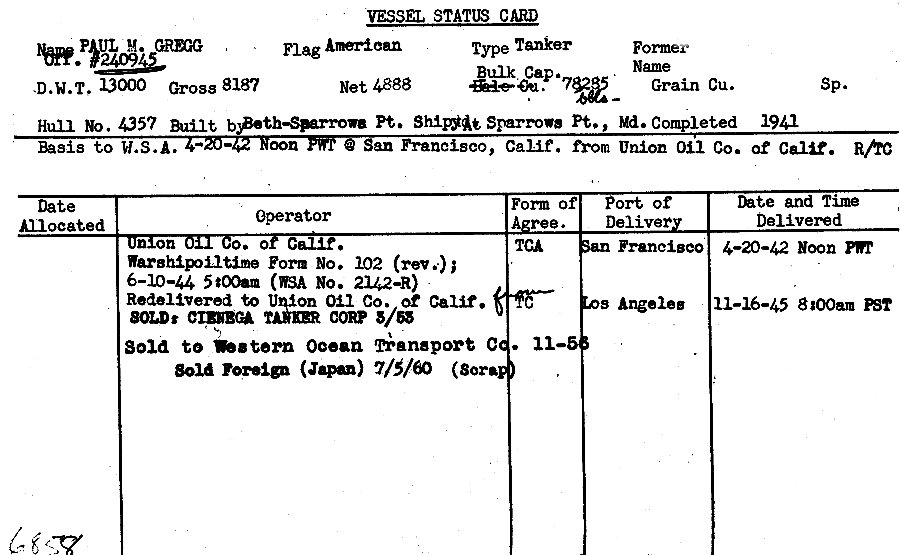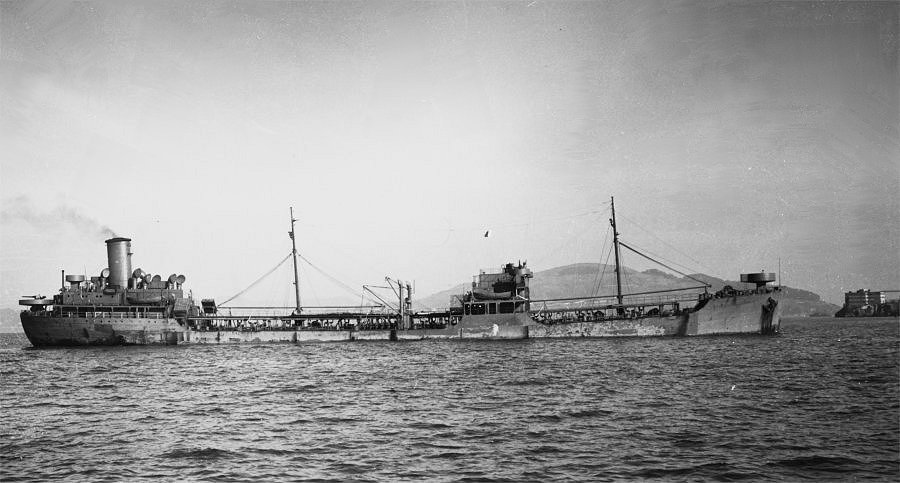Auke Visser's Famous T - Tankers Pages | home
Paul M. Gregg
A "Look A Like" T2-Tanker
PAUL M. GREGG, US, 1ST (aft), (13)
8,187 GRT for Union Oil Company of California, Los Angeles , 445.4 x 64.2
Tanker built by Bethlehem Sparrow's Point Shipyard, Inc., Sparrow's Point, Md., (8), #4357, 240945
1954 - Cienega Tanker Corp., Wilmington, Del. [Union Oil Co. of Calif.]
1956 - Western Ocean Transport Co., Wilmington, Del.
Broken up at Yokosuka 1960, arrived 4.07.1960 in tow,
work began in 9.1960 (sold to Mitsubishi Shoji K.K.)
( See photos below )
The Miramar Ship Index for "PAUL M. GREGG"
IDNo:
|
2240945
|
Year:
|
1941
|
Name:
|
PAUL M. GREGG
|
Keel:
|
23.12.1940
|
Type:
|
Tanker
|
Launch Date:
|
14.06.1941
|
Flag:
|
USA
|
Date of completion:
|
22.08.1941
|
Tons:
|
8187
|
Link:
|
1647
|
DWT:
|
12849
|
Yard No:
|
4357
|
Length overall:
|
141.1
|
Ship Design:
|
Custom
|
LPP:
|
134.7
|
Country of build:
|
USA
|
Beam:
|
19.6
|
Builder:
|
Bethlehem-Sparrows Point SY
|
Material of build:
|
Location of yard:
|
Sparrows Point
|
|
Number of screws/Mchy/Speed(kn):
|
1ST-13
|
Subsequent History:
--
Disposal Data:
Scrapped at Yokosuka 04.07.1960 [ By Mitsubishi Shoji KK ]
History:
ON
|
LR/IMO
|
ID
|
Year
|
Name
|
Tons
|
Change
|
Registered Owner
|
240945
|
2240945
|
1941
|
PAUL M. GREGG
|
8187
|
Union Oil Co of California
|
||
240945
|
2240945
|
1941
|
PAUL M. GREGG
|
8187
|
1954
|
Cienega Tanker Corp.
|
|
240945
|
2240945
|
1941
|
PAUL M. GREGG
|
8187
|
1956
|
Western Ocean Tpt Co.
|
Source : Pacific Marine Review, Volume 38, July 1941.
New Union Oil Tanker Launched
Bethlehem Sparrows Point Yard Puts Over S.S. Paul M. Gregg for Pacific Coast Service
An important addition was made to the rapidly growing fleet of American tankers when the S.S. Paul M. Gregg was launched June 14 at 11 a. m. (E.S.T.), at the Sparrows Point Yard of Bethlehem Steel Company, Shipbuilding Division. The new vessel, the keel of which was laid on December 23, 1940, is being built for Vnion Oil Company of California and will be used in regular service on the Pacific Coast. Mrs. Charlotte D. Gregg, of Pasadena, California, was the sponsor. Her husband, for whom the vessel is named, was for many years vice president and a member of the executive committee and the board of directors of the Vnion Oil Company. Mr. Gregg retired from these positions last year.
The Paul M. Gregg has a deadweight of about 13,00 tons and has a tank capacity of 103,445 barrels, or 4,344,690, gallons of oil. The cargo tank space is divided into 24 compartments, allowing many grades of oil to be carried at one time. Pumping capacity is designed to load or unload the vessel in less than 12 hours.
The principal dimensions are as follows: Length overall, 463 feet; molded beam, 64 feet; molded depth, 34 ft. 10 in.; draft, 28 ft. 6 in.; speed, 13 knots.
The propelling machinery consists of a single screw installation of Bethlehem-built turbines, developing 3500 shaft horsepower. Steam will be supplied by two water tube oil burning boilers. The ship is fitted with a Con-tra-rudder to augment the propulsive effect of the screw.
The Paul M. Gregg represents the latest in tanker design. Extensive use of welding and application of the Bethlehem-Frear system to longitudinals and bulkheads insure a light, yet strong framing with a substantial increase in paying deadweight for the given displacement. The vessel is of the conventional tanker appearance, with separate forecastle, midship navigating bridge, and poop, connected by the usual catwalk. Raked stem and cruiser stern give the vessel a pleasing and shipshape appearance.
Modern and complete navigation equipment has been installed in the pilot house amidships. This includes complete gyro compass equipment, in addition to the magnetic compasses, and Gyro-Pilot automatic steering control. A Fathometer and an electric sounding machine are also installed, as well as a continuous three-day course recorder. Among interesting safety devices are independent radio receivers, an automatic S.O.S. receiver, radio direction finder and complete radio communication equipment, one set of which has a range of about 2000 miles. Automatic alarms indicate burning out of running lights, failure of oil supply and similar disturbances. An inert gas system of the Union Oil Company's type is fitted for protection of the cargo tanks.
Excellent accommodations are provided for 13 officers and a crew of 30 men. The men are housed in 15 rooms, two men in each, while the officers have individual rooms. Accommodations also include smoking rooms and mess rooms for officers and crew, hospital, laundry, cold storage and provision storage.
As the vessel will operate in warm climates, sufficient ventilation has been provided to insure fifteen complete changes of air hourly in all living quarters and mess rooms. Chilled drinking water is also supplied, an important feature on ships making tropical runs, and the ship has a distillation apparatus which, in emergencies, can produce drinking water from sea water.
The ship is built to the highest class of the American Bureau of Shipping, under their special survey, and in accordance with the latest regulations of the Bureau of Marine Inspection and Navigation, and also meets with the requirements for the Panama and Suez Canals.
|
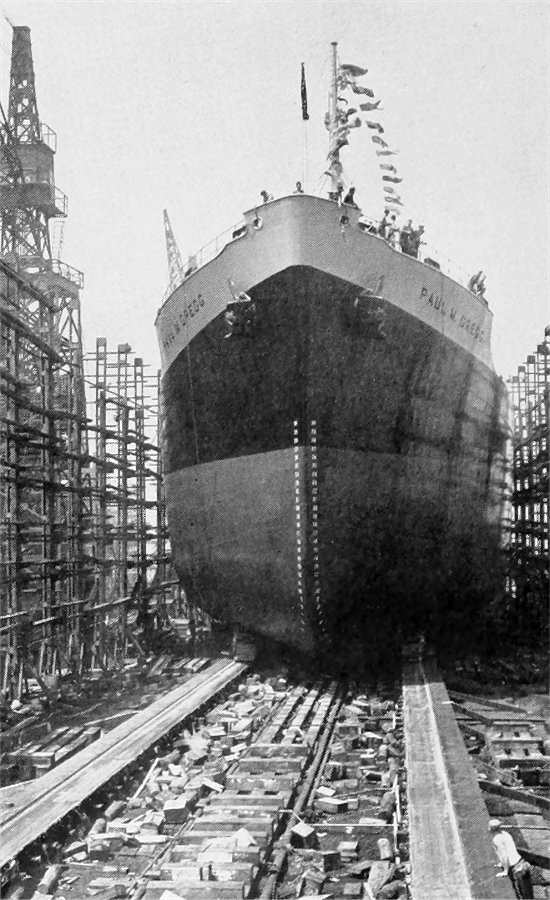
Launch of the "Paul M. Gregg", June 14th, 1941.
"Paul M. Gregg" entering San Francisco, California, during World War II. Owned by the Union Oil
Co. of California.
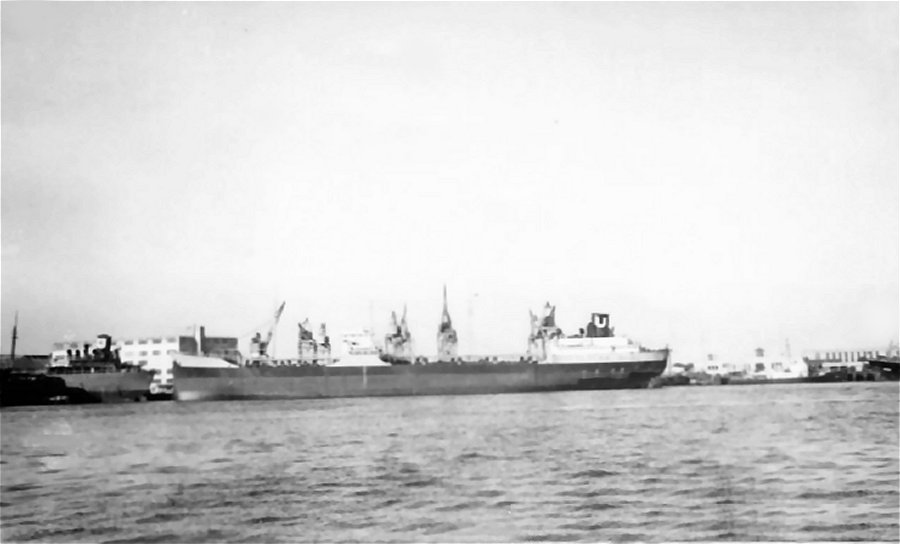
( Photo Copyright Robert Muirhead )
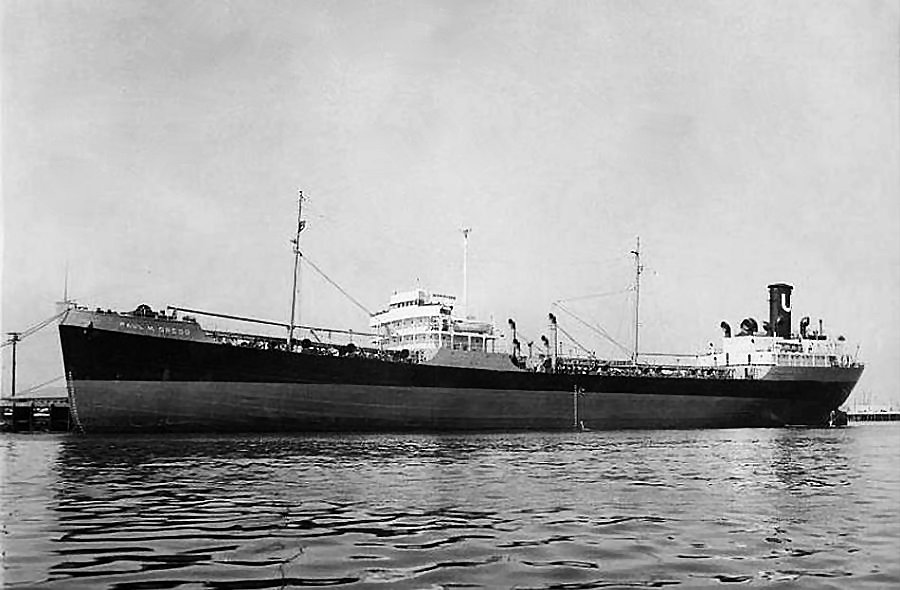
"Paul M. Gregg", location and date unknown.
( Photo Copyright Reserved )
